Retrospection of Research on Dragonfly and Damselfly (Odonata) During Past Fifty Years: A Bibliometric Review
Simple Summary
Abstract
1. Introduction
2. Materials and Methods
2.1. Data Acquisition
2.2. Data Analysis
2.3. Parameter Design
3. Results
3.1. Publication Output Analysis
3.2. Analysis of Research Countries
3.3. Analysis of Research Institutions
3.4. Analysis of Research Authors
3.5. Journal Co-Citation Analysis
3.6. Analysis of Keywords
3.7. Analysis of Cited References
4. Discussion
4.1. Publication Output Trends
4.2. Geographic Distribution of Research
4.3. Institutional Contributions and Collaboration
4.4. Authorship Patterns and Researcher Networks
4.5. Journals and Research Dissemination
4.6. Research Themes from Keywords and Emerging Frontiers
4.7. Influential Works and Knowledge Base
5. Conclusions
Author Contributions
Funding
Data Availability Statement
Acknowledgments
Conflicts of Interest
References
- Newton, L.; Tolman, E.; Kohli, M.; Ware, J.L. Evolution of Odonata: Genomic insights. Curr. Opin. Insect Sci. 2023, 58, 101073. [Google Scholar] [CrossRef]
- Serrano-Meneses, M.A.; Córdoba-Aguilar, A.; Azpilicueta-Amorín, M.; González-Soriano, E.; Székely, T. Sexual selection, sexual size dimorphism and Rensch’s rule in Odonata. J. Evol. Biol. 2008, 21, 1259–1273. [Google Scholar] [CrossRef]
- Monzó, J.C.; Verdú, J.R. Effects of restoration and management of Mediterranean traditional water systems on Odonata alpha diversity: A long-term monitoring survey. Biodivers. Conserv. 2022, 31, 227–243. [Google Scholar] [CrossRef]
- Wellenreuther, M.; Dudaniec, R.Y.; Lancaster, L.T. Genomic insights into micro- and macro-evolutionary processes in Odonata. In Dragonflies and Damselflies: Model Organisms for Ecological and Evolutionary Research, 2nd ed.; Córdoba-Aguilar, A., Beatty, C.D., Bried, J.T., Eds.; Oxford University Press: Oxford, UK, 2023; pp. 7–20. [Google Scholar] [CrossRef]
- Kutcher, T.E.; Bried, J.T. Adult Odonata conservatism as an indicator of freshwater wetland condition. Ecol. Indic. 2014, 38, 31–39. [Google Scholar] [CrossRef]
- Golfieri, B.; Hardersen, S.; Maiolini, B.; Surian, N. Odonates as indicators of the ecological integrity of the river corridor: Development and application of the Odonate River Index (ORI) in northern Italy. Ecol. Indic. 2016, 61, 234–247. [Google Scholar] [CrossRef]
- Janssen, A.; Hunger, H.; Konold, W.; Pufal, G.; Staab, M. Simple pond restoration measures increase dragonfly (Insecta: Odonata) diversity. Biodivers. Conserv. 2018, 27, 2311–2328. [Google Scholar] [CrossRef]
- Guillermo-Ferreira, R.; Juen, L. Odonate ethodiversity as a bioindicator of anthropogenic impact. Int. J. Odonatol. 2021, 24, 149–157. [Google Scholar] [CrossRef] [PubMed]
- Bush, A.; Theischinger, G.; Nipperess, D.; Turak, E.; Hughes, L. Dragonflies: Climate canaries for river management. Divers. Distrib. 2013, 19, 86–97. [Google Scholar] [CrossRef]
- Bush, A.A.; Nipperess, D.A.; Duursma, D.E.; Theischinger, G.; Turak, E.; Hughes, L. Continental-scale assessment of risk to the Australian Odonata from climate change. PLoS ONE 2014, 9, e88958. [Google Scholar] [CrossRef]
- Silva, L.F.R.; Castro, D.M.P.; Juen, L.; Callisto, M.; Hughes, R.M.; Hermes, M.G. Functional responses of Odonata larvae to human disturbances in Neotropical savanna headwater streams. Ecol. Indic. 2021, 133, 108367. [Google Scholar] [CrossRef]
- Tolman, E.R.; Bruchim, O.R.; Driever, E.S.; Jordan, D.; Kohli, M.K.; Montague, L.; Park, J.; Park, S.; Rosario, M.; Ryu, J.L.; et al. Changes in effective population size of Odonata in response to climate change revealed through genomics. Int. J. Odonatol. 2023, 26, 205–211. [Google Scholar] [CrossRef]
- Holt, R.D.; Lawton, J.H. The ecological consequences of shared natural enemies. Annu. Rev. Ecol. Evol. Syst. 1994, 25, 495–520. [Google Scholar] [CrossRef]
- Rahong, P.; Techakijvej, C.; Phalaraksh, C. Predators as biocontrol agents of mosquito larvae in small and large habitats in Chiang Mai, Thailand. J. Vector Ecol. 2023, 48, 78–88. [Google Scholar] [CrossRef]
- Burkle, L.A.; Mihaljevic, J.R.; Smith, K.G. Effects of an invasive plant transcend ecosystem boundaries through a dragonfly-mediated trophic pathway. Oecologia 2012, 170, 1045–1052. [Google Scholar] [CrossRef] [PubMed]
- Chou, A.; Lin, C.; Cronin, T.W. Visual metamorphoses in insects and malacostracans: Transitions between an aquatic and terrestrial life. Arthropod Struct. Dev. 2020, 59, 100974. [Google Scholar] [CrossRef] [PubMed]
- Rowe, R.J. Review of “Dragonflies: Behaviour and Ecology of Odonata” by P.S. Corbet. Aust. J. Entomol. 2003, 42, 210–211. [Google Scholar] [CrossRef]
- Corbet, P.S. Dragonflies: Behaviour and Ecology of Odonata; Harley Books: Colchester, UK, 1999; p. 829. [Google Scholar]
- Bastos, R.C.; Brasil, L.S.; Oliveira-Junior, J.M.B.; Carvalho, F.G.; Lennox, G.D.; Barlow, J.; Juen, L. Morphological and phylogenetic factors structure the distribution of damselfly and dragonfly species (Odonata) along an environmental gradient in Amazonian streams. Ecol. Indic. 2021, 122, 107257. [Google Scholar] [CrossRef]
- Béthoux, O.; Anderson, J.M. New light shed on Triadophlebiomorpha wing morphology and systematics (Insecta: Odonata). Geodiversitas 2023, 45, 479–496. [Google Scholar] [CrossRef]
- Corbet, P.S.; Suhling, F.; Soendgerath, D. Voltinism of Odonata: A review. Int. J. Odonatol. 2006, 9, 1–44. [Google Scholar] [CrossRef]
- Kalkman, V.J.; Clausnitzer, V.; Dijkstra, K.-D.B.; Orr, A.G.; Paulson, D.R.; van Tol, J. Global diversity of dragonflies (Odonata) in freshwater. Hydrobiologia 2008, 595, 351–363. [Google Scholar] [CrossRef]
- Dumont, H.J.; Vierstraete, A.; Vanfleteren, J.R. A molecular phylogeny of the Odonata (Insecta). Syst. Entomol. 2010, 35, 6–18. [Google Scholar] [CrossRef]
- Walia, G.K.; Dhillon, G.K. Phylogenetic analysis of Aciagrion Selys (Odonata: Coenagrionidae). J. Nat. Hist. 2023, 57, 1610–1628. [Google Scholar] [CrossRef]
- Dijkstra, K.-D.B.; Bechly, G.; Bybee, S.M.; Dow, R.A.; Dumont, H.J.; Fleck, G.; Garrison, R.W.; Hämäläinen, M.; Kalkman, V.J.; Karube, H.; et al. The classification and diversity of dragonflies and damselflies (Odonata). In: Zhang, Z.-Q. (Ed.) Animal Biodiversity: An Outline of Higher-Level Classification and Survey of Taxonomic Richness (Addenda 2013). Zootaxa 2013, 3703, 36–45. [Google Scholar] [CrossRef]
- Geraldo de Carvalho, F.; Duarte, L.; Nakamura, G.; Dubal dos Santos Seger, G.; Juen, L. Changes of phylogenetic and taxonomic diversity of Odonata (Insecta) in response to land use in Amazonia. Forests 2021, 12, 1061. [Google Scholar] [CrossRef]
- Wellenreuther, M.; Svensson, E.I.; Hansson, B. Sexual selection and genetic colour polymorphisms in animals. Mol. Ecol. 2014, 23, 5398–5414. [Google Scholar] [CrossRef] [PubMed]
- Futahashi, R. Color vision and color formation in dragonflies. Curr. Opin. Insect Sci. 2016, 17, 32–39. [Google Scholar] [CrossRef]
- Okude, G.; Futahashi, R. Pigmentation and color pattern diversity in Odonata. Curr. Opin. Genet. Dev. 2021, 69, 14–20. [Google Scholar] [CrossRef]
- Bried, J.T.; Samways, M.J. A review of odonatology in freshwater applied ecology and conservation science. Freshw. Sci. 2015, 34, 1023–1031. [Google Scholar] [CrossRef]
- Oliveira-Junior, J.M.B.; Rocha, T.S.; Vinagre, S.F.; Miranda-Filho, J.C.; Mendoza-Penagos, C.C.; Dias-Silva, K.; Juen, L.; Calvão, L.B. A bibliometric analysis of the global research in Odonata: Trends and gaps. Diversity 2022, 14, 1074. [Google Scholar] [CrossRef]
- Miguel, T.B.; Oliveira-Junior, J.M.B.; Ligeiro, R.; Juen, L. Odonata (Insecta) as a tool for the biomonitoring of environmental quality. Ecol. Indic. 2017, 81, 555–566. [Google Scholar] [CrossRef]
- Palacino-Rodríguez, F. Two decades of progress in over one hundred years of study: Present status of Odonata research in Colombia. Odonatologica 2016, 45, 327–334. [Google Scholar] [CrossRef]
- Chen, C. CiteSpace II: Detecting and visualizing emerging trends and transient patterns in scientific literature. J. Am. Soc. Inf. Sci. Technol. 2006, 57, 359–377. [Google Scholar] [CrossRef]
- Chen, C.; Ibekwe-SanJuan, F.; Hou, J. The structure and dynamics of cocitation clusters: A multiple-perspective cocitation analysis. J. Am. Soc. Inf. Sci. Technol. 2010, 61, 1386–1409. [Google Scholar] [CrossRef]
- Brandes, U. A faster algorithm for betweenness centrality. J. Math. Sociol. 2001, 25, 163–177. [Google Scholar] [CrossRef]
- Kleinberg, J. Bursty and hierarchical structure in streams. Data Min. Knowl. Discov. 2003, 7, 373–397. [Google Scholar] [CrossRef]
- Egghe, L. Theory and practise of the g-index. Scientometrics 2006, 69, 131–152. [Google Scholar] [CrossRef]
- Monteiro Júnior, C.d.S.; Juen, L.; Hamada, N. Analysis of urban impacts on aquatic habitats in the central Amazon basin: Adult odonates as bioindicators of environmental quality. Ecol. Indic. 2015, 48, 303–311. [Google Scholar] [CrossRef]
- Clausnitzer, V.; Kalkman, V.J.; Ram, M.; Collen, B.; Baillie, J.E.M.; Bedjanič, M.; Darwall, W.R.T.; Dijkstra, K.-D.B.; Dow, R.; Hawking, J.; et al. Odonata enter the biodiversity crisis debate: The first global assessment of an insect group. Biol. Conserv. 2009, 142, 1864–1869. [Google Scholar] [CrossRef]
- Dijkstra, K.-D.B.; Kalkman, V.J.; Dow, R.A.; Stokvis, F.R.; van Tol, J. Redefining the damselfly families: A comprehensive molecular phylogeny of Zygoptera (Odonata). Syst. Entomol. 2014, 39, 68–96. [Google Scholar] [CrossRef]
- Stoks, R.; Córdoba-Aguilar, A. Evolutionary ecology of Odonata: A complex life cycle perspective. Annu. Rev. Entomol. 2012, 57, 249–265. [Google Scholar] [CrossRef]
- Svensson, E.I.; Abbott, J.; Härdling, R. Female polymorphism, frequency dependence, and rapid evolutionary dynamics in natural populations. Am. Nat. 2005, 165, 567–576. [Google Scholar] [CrossRef]
- Bybee, S.M.; Ogden, T.H.; Branham, M.A.; Whiting, M.F. Molecules, morphology and fossils: A comprehensive approach to odonate phylogeny and the evolution of the odonate wing. Cladistics 2008, 24, 477–514. [Google Scholar] [CrossRef]
- Oliveira-Junior, J.M.B.D.; Shimano, Y.; Gardner, T.A.; Hughes, R.M.; de Marco Júnior, P.; Juen, L. Neotropical dragonflies (Insecta: Odonata) as indicators of ecological condition of small streams in the eastern Amazon. Austral Ecol. 2015, 40, 733–744. [Google Scholar] [CrossRef]
- Oliveira-Junior, J.M.B.; Juen, L. The Zygoptera/Anisoptera Ratio (Insecta: Odonata): A New Tool for Habitat Alterations Assessment in Amazonian Streams. Neotrop. Entomol. 2019, 48, 552–560. [Google Scholar] [CrossRef]
- Kalkman, V.J.; Boudot, J.-P.; Bernard, R.; De Knijf, G.; Suhling, F.; Termaat, T. Diversity and conservation of European dragonflies and damselflies (Odonata). Hydrobiologia 2018, 811, 269–282. [Google Scholar] [CrossRef]
- Oliveira-Junior, J.M.B.D.; De Marco Junior, P.; Dias-Silva, K.; Leitão, R.P.; Leal, C.G.; Pompeu, P.S.; Gardner, T.A.; Hughes, R.M.; Juen, L. Effects of human disturbance and riparian conditions on Odonata (Insecta) assemblages in eastern Amazon basin streams. Limnologica 2017, 66, 31–39. [Google Scholar] [CrossRef]
- Bybee, S.; Córdoba-Aguilar, A.; Duryea, M.C.; Futahashi, R.; Hansson, B.; Lorenzo-Carballa, M.O.; Schilder, R.; Stoks, R.; Suvorov, A.; Svensson, E.I.; et al. Odonata (dragonflies and damselflies) as a bridge between ecology and evolutionary genomics. Front. Zool. 2016, 13, 46. [Google Scholar] [CrossRef] [PubMed]
- Bowler, D.E.; Eichenberg, D.; Conze, K.-J.; Suhling, F.; Baumann, K.; Benken, T.; Bönsel, A.; Bittner, T.; Drews, A.; Günther, A.; et al. Winners and losers over 35 years of dragonfly and damselfly distributional change in Germany. Divers. Distrib. 2021, 27, 1353–1366. [Google Scholar] [CrossRef]
- Raebel, E.M.; Merckx, T.; Riordan, P.; Macdonald, D.W.; Thompson, D.J. The dragonfly delusion: Why it is essential to sample exuviae to avoid biased surveys. J. Insect Conserv. 2010, 14, 523–533. [Google Scholar] [CrossRef]
- Garrison, R.W.; Ellenrieder, N.V.; Louton, J.A. Damselfly Genera of the New World: An Illustrated and Annotated Key to the Zygoptera; Johns Hopkins University Press: Baltimore, MD, USA, 2010; p. 490. [Google Scholar]
- Dijkstra, K.-D.B.; Lewington, R. Field Guide to the Dragonflies of Britain and Europe; British Wildlife Publishing: Devon, UK, 2006; p. 320. [Google Scholar]
- McPeek, M.A. The consequences of changing the top predator in a food web: A comparative experimental approach. Ecol. Monogr. 1998, 68, 1–23. [Google Scholar] [CrossRef]
- Thomas, C.D.; Cameron, A.; Green, R.E.; Bakkenes, M.; Beaumont, L.J.; Collingham, Y.C.; Erasmus, B.F.N.; de Siqueira, M.F.; Grainger, A.; Hannah, L.; et al. Extinction risk from climate change. Nature 2003, 427, 145–148. [Google Scholar] [CrossRef] [PubMed]
- Bomphrey, R.J.; Nakata, T.; Henningsson, P.; Lin, H.-T. Flight of the dragonflies and damselflies. Phil. Trans. R. Soc. B 2016, 371, 20150389. [Google Scholar] [CrossRef] [PubMed]
- Appel, E.; Heepe, L.; Lin, C.-P.; Gorb, S.N. Ultrastructure of dragonfly wing veins: Composite structure of fibrous material supplemented by resilin. J. Anat. 2015, 227, 561–582. [Google Scholar] [CrossRef]
- Eagles-Smith, C.A.; Willacker, J.J.; Nelson, S.J.; Pritz, C.M.F.; Krabbenhoft, D.P.; Chen, C.Y.; Ackerman, J.T.; Grant, E.H.C.; Pilliod, D.S. A national-scale assessment of mercury bioaccumulation in United States national parks using dragonfly larvae as biosentinels through a citizen-science framework. Environ. Sci. Technol. 2020, 54, 8779–8790. [Google Scholar] [CrossRef]
- Maneechan, W.; Prommi, T.O. Occurrence of microplastics in edible aquatic insect Pantala sp. (Odonata: Libellulidae) from rice fields. PeerJ 2022, 10, e12902. [Google Scholar] [CrossRef] [PubMed]
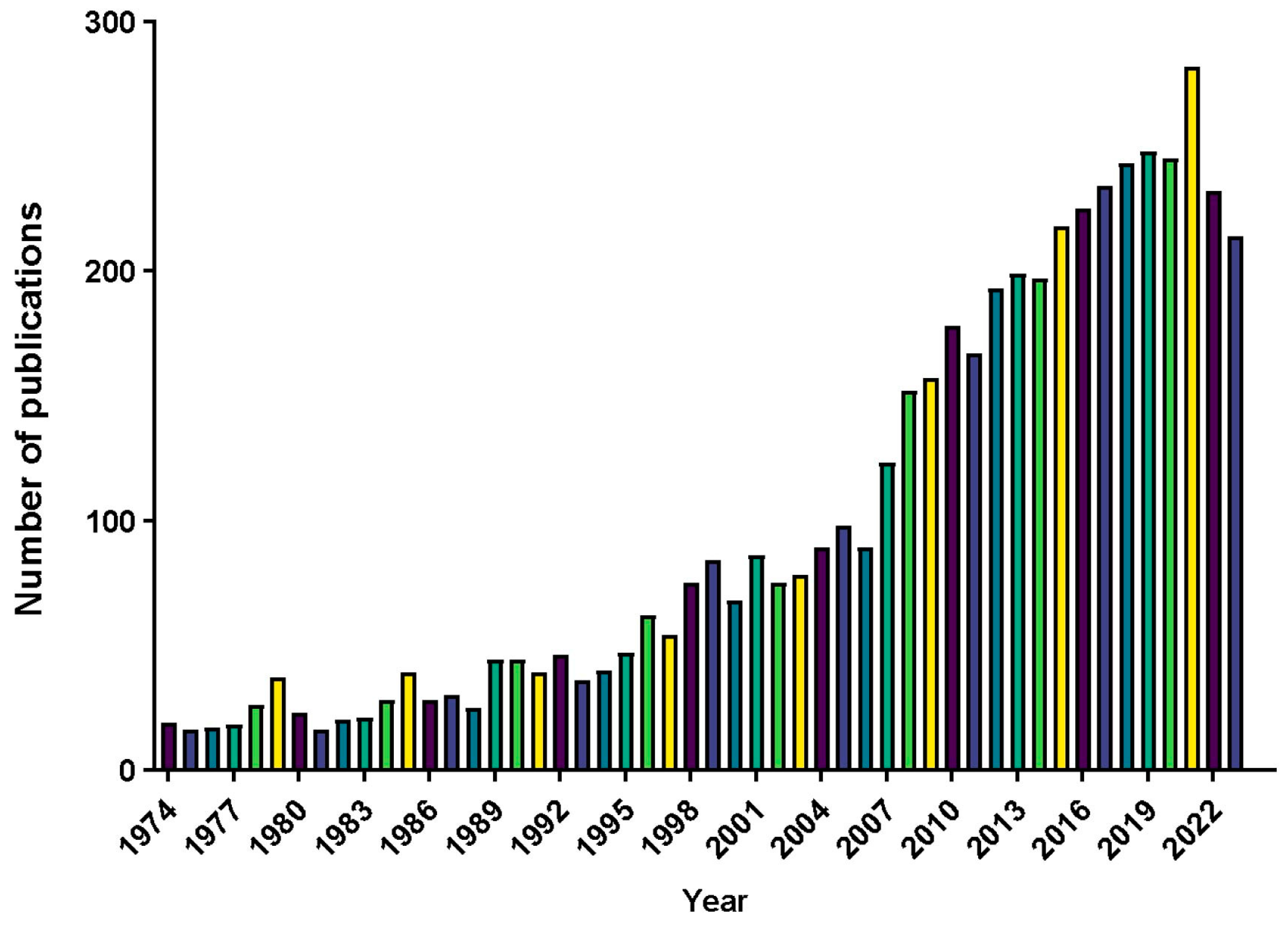

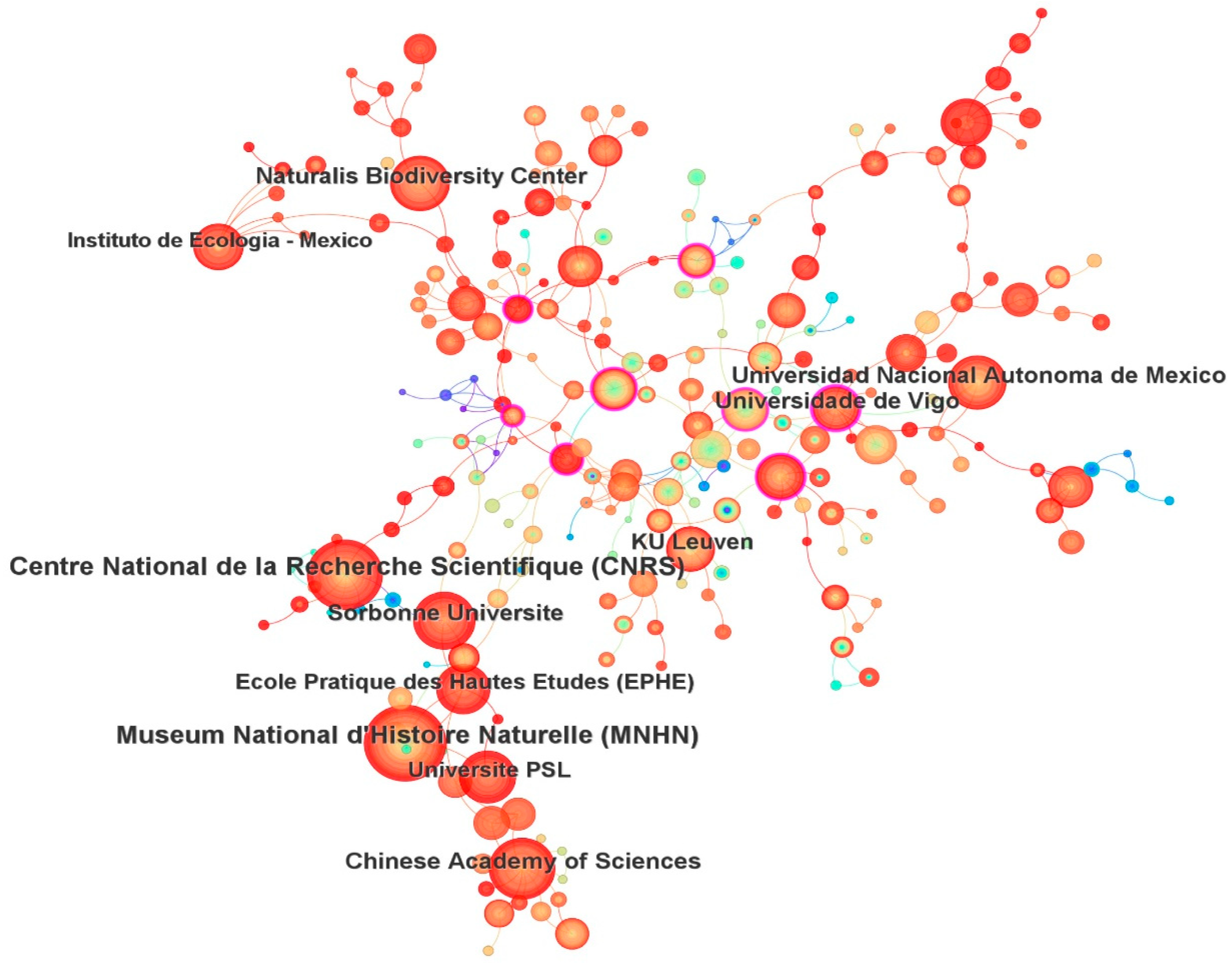

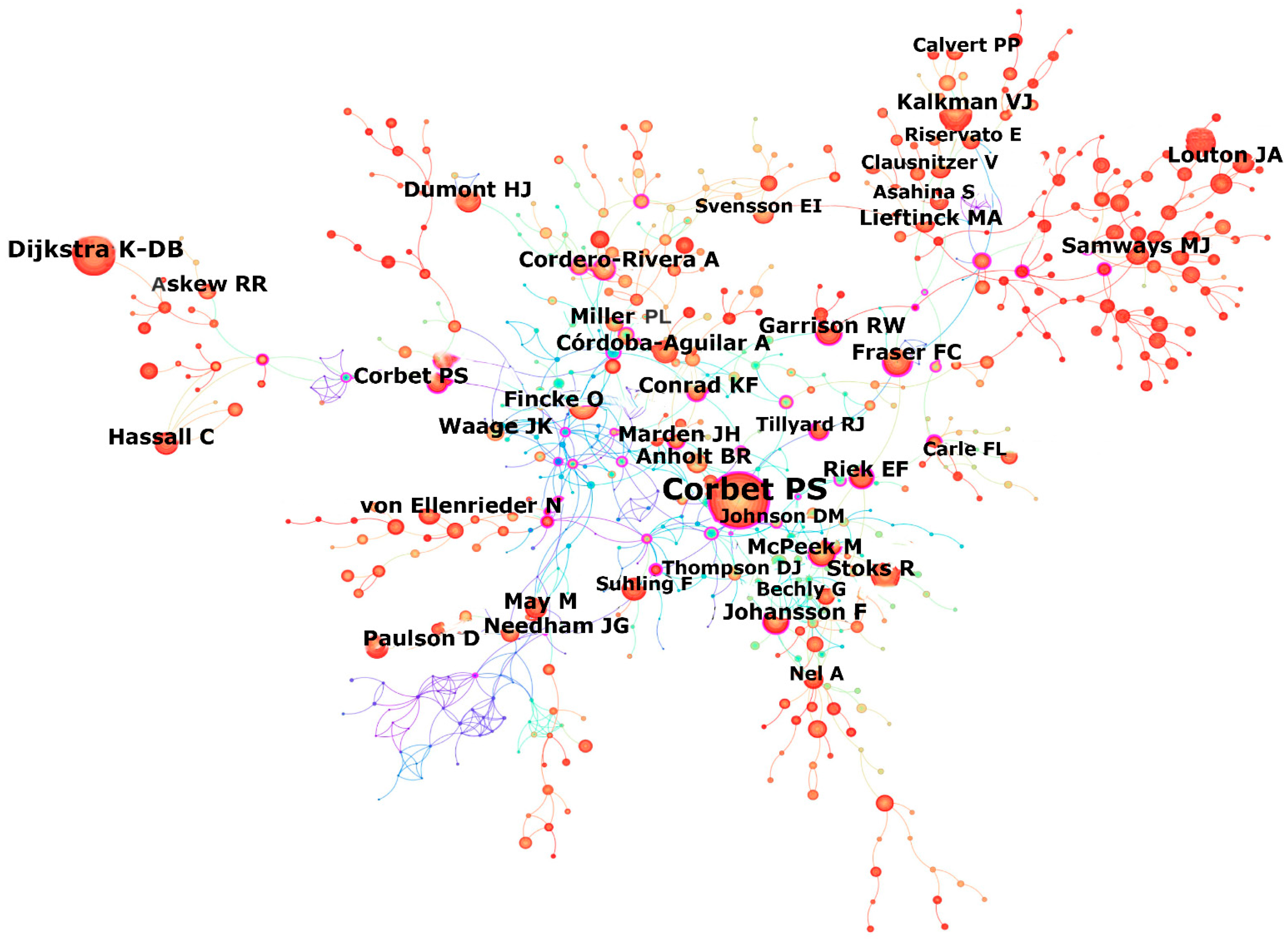

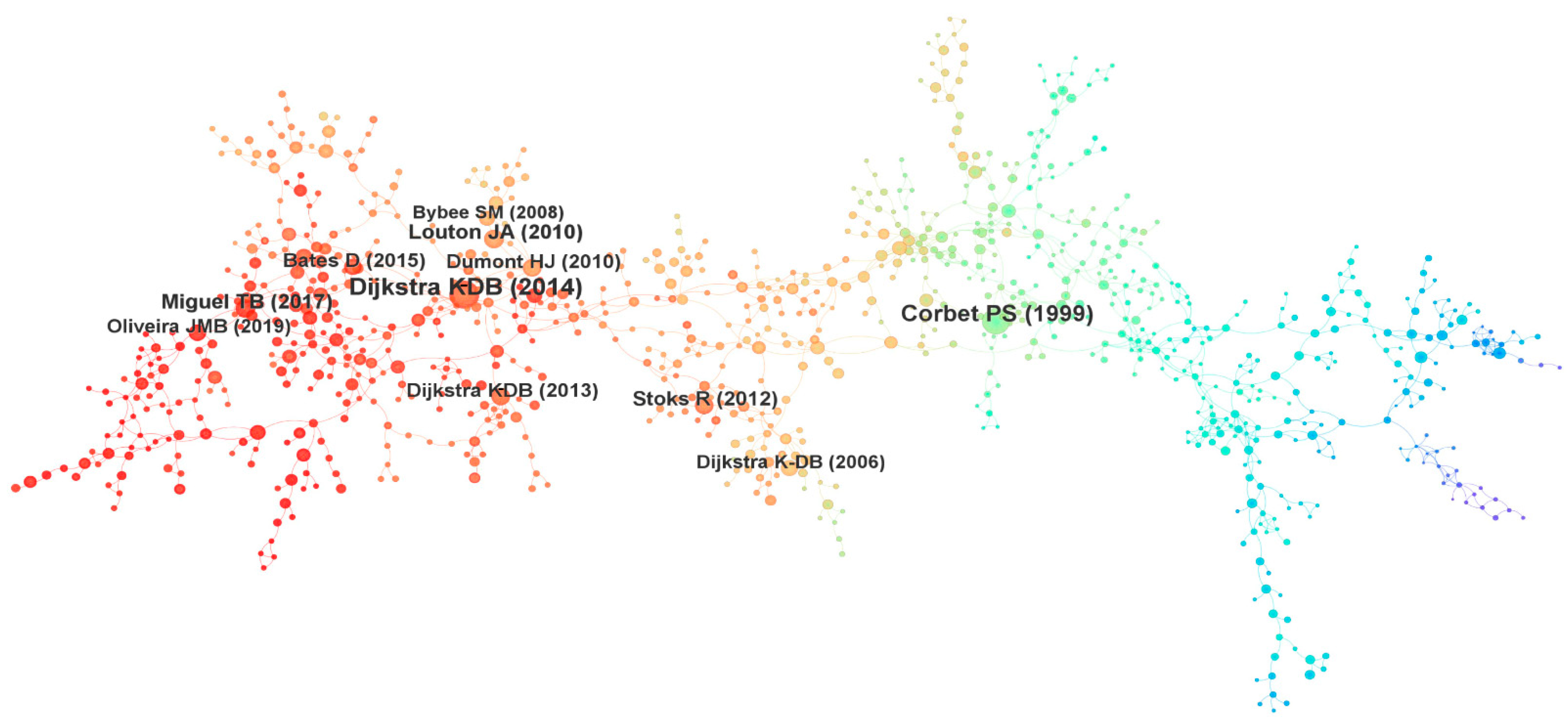
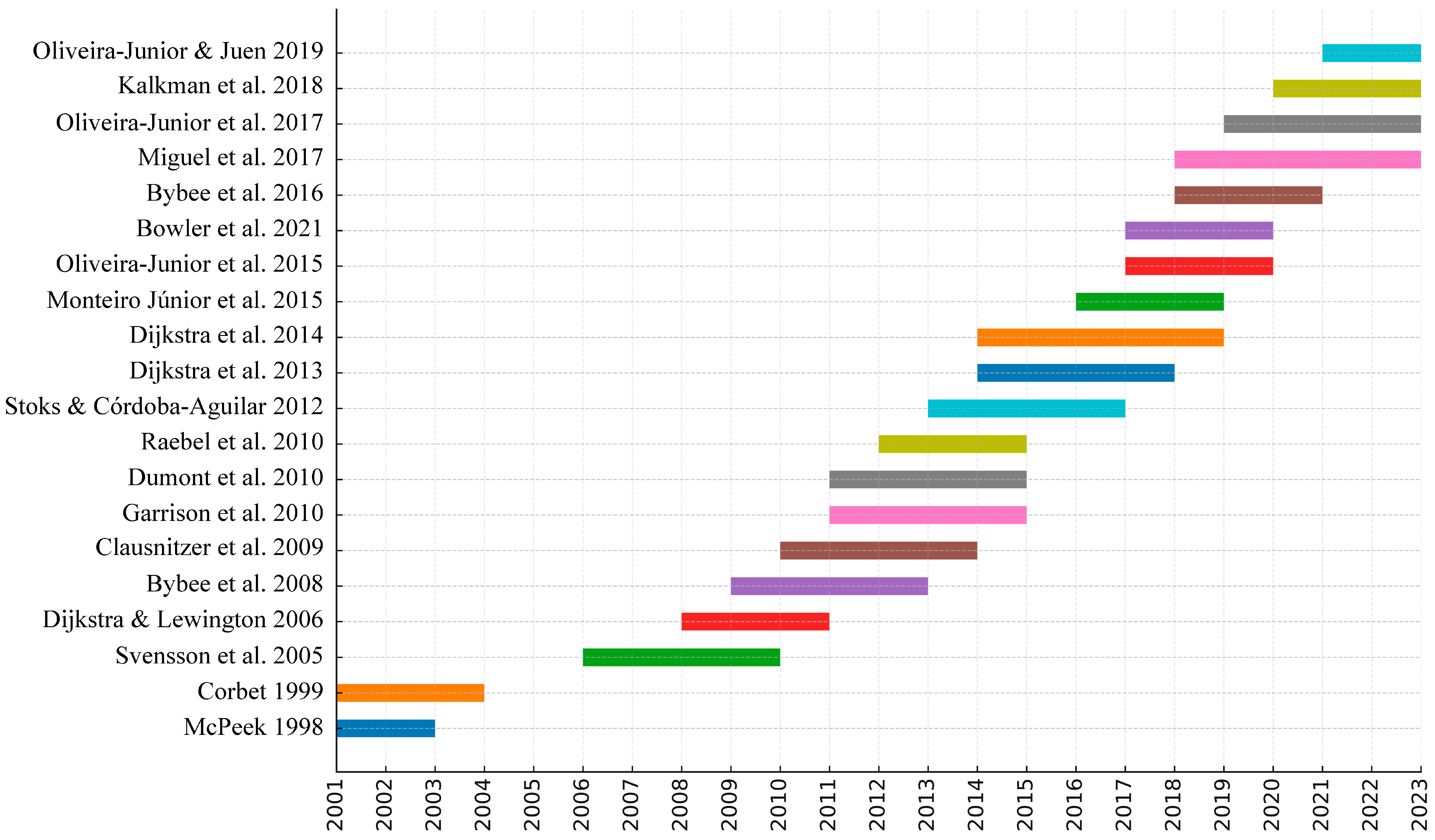
| Publications | Betweenness Centrality | Country |
|---|---|---|
| 1003 | 0.07 | USA |
| 412 | 0.08 | Germany |
| 411 | 0 | China |
| 362 | 0.03 | Brazil |
| 301 | 0.29 | France |
| 300 | 0.03 | England |
| 280 | 0.11 | Canada |
| 248 | 0 | Japan |
| 236 | 0.11 | Belgium |
| 226 | 0 | Mexico |
| Publications | BC | Institution | Country |
|---|---|---|---|
| 201 | 0.06 | Centre National de la Recherche Scientifique | France |
| 195 | 0.08 | Museum National d’Histoire Naturelle | France |
| 135 | 0.06 | Chinese Academy of Sciences | Peoples’ R China |
| 118 | 0.02 | Universidad Nacional Autónoma de México | Mexico |
| 115 | 0.09 | Sorbonne Universite | France |
| 110 | 0.04 | Naturalis Biodiversity Center | The Netherlands |
| 104 | 0.24 | Universidade de Vigo | Spain |
| 101 | 0.01 | KU Leuven | Belgium |
| 84 | 0.04 | Universite PSL | Spain |
| 82 | 0.02 | Ecole Pratique des Hautes Etudes | France |
| Ranking | Author | Publications | BC | Author | Citations | Betweenness Centrality |
|---|---|---|---|---|---|---|
| 1 | Nel A. | 164 | 0.05 | Corbet P.S. | 1742 | 0.26 |
| 2 | Stoks R. | 123 | 0.10 | Dijkstra K.-D.B. | 623 | 0 |
| 3 | Cordero-Rivera A. | 80 | 0.15 | Fincke O. | 568 | 0.08 |
| 4 | Juen L. | 72 | 0.04 | Stoks R. | 426 | 0.02 |
| 5 | Johansson F. | 69 | 0.12 | May M. | 414 | 0.10 |
| 6 | Córdoba-Aguilar A. | 66 | 0.16 | McPeek M. | 397 | 0.12 |
| 7 | Novelo-Gutiérrez R. | 59 | 0.02 | Johansson F. | 390 | 0.12 |
| 8 | Samways M.J. | 58 | 0.05 | Kalkman V.J. | 379 | 0 |
| 9 | Thompson D.J. | 50 | 0.04 | Fraser F.C. | 378 | 0.33 |
| 10 | Dow R.A. | 42 | 0.09 | Garrison R.W. | 375 | 0.19 |
| Ranking | Journals | Cited Frequency | BC | Impact Factor (2023) |
|---|---|---|---|---|
| 1 | Odonatologica | 2672 | 0.07 | 0.30 |
| 2 | Ecology | 1421 | 0.06 | 0.59 |
| 3 | Science | 1213 | 0.07 | 56.90 |
| 4 | Nature | 1193 | 0.08 | 64.80 |
| 5 | Canadian Journal of Zoology | 1185 | 0.08 | 0.869 |
| 6 | American Naturalist | 1157 | 0.05 | 2.067 |
| 7 | Animal Behavior | 1108 | 0 | 1.932 |
| 8 | Hydrobiologia | 1097 | 0.02 | 2.60 |
| 9 | Evolution | 1032 | 0.01 | 2.614 |
| 10 | Behavior Economics | 1030 | 0.02 | 2.161 |
| Ranking | Frequency | Keywords | Ranking | Frequency | Keywords |
|---|---|---|---|---|---|
| 1 | 757 | Odonata | 11 | 227 | conservation |
| 2 | 442 | dragonfly | 12 | 212 | selection |
| 3 | 413 | body size | 13 | 205 | life history |
| 4 | 398 | evolution | 14 | 198 | biodiversity |
| 5 | 362 | insecta | 15 | 187 | damselfly |
| 6 | 301 | behavior | 16 | 180 | sexual selection |
| 7 | 288 | Zygoptera | 17 | 161 | Anisoptera |
| 8 | 273 | diversity | 18 | 156 | climate change |
| 9 | 246 | patterns | 19 | 151 | community |
| 10 | 232 | new species | 20 | 140 | assemblages |
| ID | Frequency | Year | Title |
|---|---|---|---|
| 1 | 494 | 1999 | Dragonflies: behavior and ecology of Odonata. |
| 2 | 288 | 2008 | Global diversity of dragonflies (Odonata) in freshwater |
| 3 | 284 | 2009 | Odonata enter the biodiversity crisis debate: The first global assessment of an insect group |
| 4 | 260 | 2014 | Redefining the damselfly families: a comprehensive molecular phylogeny of Zygoptera (Odonata) |
| 5 | 226 | 2012 | Evolutionary Ecology of Odonata: A Complex Life Cycle Perspective |
| 6 | 218 | 2005 | Female polymorphism, frequency dependence, and rapid evolutionary dynamics in natural populations |
| 7 | 149 | 2008 | Molecules, morphology and fossils: a comprehensive approach to odonate phylogeny and the evolution of the odonate wing |
| 8 | 143 | 2013 | The classification and diversity of dragonflies and damselflies (Odonata) |
| 9 | 126 | 2010 | A molecular phylogeny of the Odonata (Insecta) |
| 10 | 115 | 2015 | Neotropical dragonflies (Insecta: Odonata) as indicators of ecological condition of small streams in the eastern Amazon |
Disclaimer/Publisher’s Note: The statements, opinions and data contained in all publications are solely those of the individual author(s) and contributor(s) and not of MDPI and/or the editor(s). MDPI and/or the editor(s) disclaim responsibility for any injury to people or property resulting from any ideas, methods, instructions or products referred to in the content. |
© 2025 by the authors. Licensee MDPI, Basel, Switzerland. This article is an open access article distributed under the terms and conditions of the Creative Commons Attribution (CC BY) license (https://creativecommons.org/licenses/by/4.0/).
Share and Cite
Fan, G.-Q.; Qin, S.-Z.; Hu, C.-X. Retrospection of Research on Dragonfly and Damselfly (Odonata) During Past Fifty Years: A Bibliometric Review. Insects 2025, 16, 945. https://doi.org/10.3390/insects16090945
Fan G-Q, Qin S-Z, Hu C-X. Retrospection of Research on Dragonfly and Damselfly (Odonata) During Past Fifty Years: A Bibliometric Review. Insects. 2025; 16(9):945. https://doi.org/10.3390/insects16090945
Chicago/Turabian StyleFan, Gang-Qiang, Shao-Zhao Qin, and Chao-Xing Hu. 2025. "Retrospection of Research on Dragonfly and Damselfly (Odonata) During Past Fifty Years: A Bibliometric Review" Insects 16, no. 9: 945. https://doi.org/10.3390/insects16090945
APA StyleFan, G.-Q., Qin, S.-Z., & Hu, C.-X. (2025). Retrospection of Research on Dragonfly and Damselfly (Odonata) During Past Fifty Years: A Bibliometric Review. Insects, 16(9), 945. https://doi.org/10.3390/insects16090945






